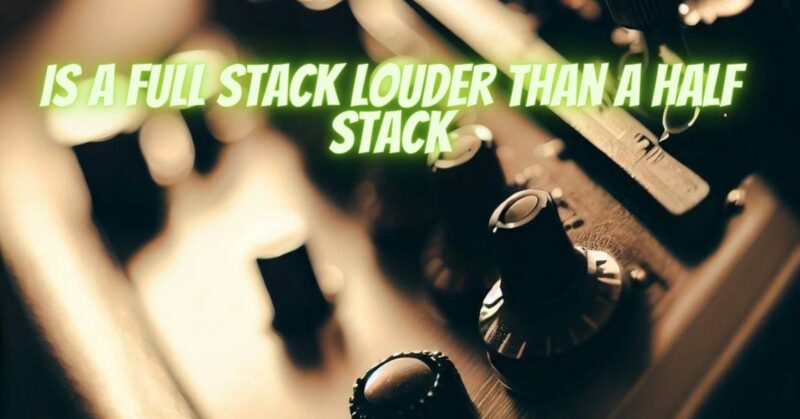When it comes to guitar amplifiers, the terms “full stack” and “half stack” are often used to describe different amplifier configurations. Many musicians wonder if a full stack is inherently louder than a half stack. In this article, we will explore the differences between full stacks and half stacks, how they affect volume output, and the factors to consider when choosing between the two setups.
Full Stack vs. Half Stack:
A full stack typically consists of a head (amplifier) and two speaker cabinets stacked vertically, forming a commanding presence on stage. The head contains the amplifier’s preamp and power amp sections, while the speaker cabinets house the speakers responsible for projecting the sound.
A half stack, on the other hand, includes the same head (amplifier) but with only one speaker cabinet instead of two. The speaker cabinet in a half stack is often larger than the individual cabinets found in a combo amp but smaller than those in a full stack.
Volume Output:
When comparing full stacks to half stacks, the volume output is influenced by several factors:
- Speaker Configuration: Full stacks have more speakers than half stacks, which means they can move more air and potentially produce a louder sound.
- Power Rating: The power rating of the amplifier head also plays a crucial role in determining volume output. A higher wattage head will generally produce a louder sound, regardless of whether it is paired with a full stack or a half stack.
- Efficiency and Sensitivity: The efficiency and sensitivity of the speakers in the cabinets can impact volume output. High-efficiency speakers can produce more sound with less power, leading to a louder overall output.
- Room Acoustics: The acoustics of the venue or performance space can significantly affect how sound travels and is perceived. The same amp setup can sound different in various environments.
Which is Louder: Full Stack or Half Stack?
In most cases, a full stack has the potential to be louder than a half stack due to its larger number of speakers. However, the actual difference in volume may not be as significant as one might think. The difference in loudness between a full stack and a half stack can be subtle and might not be noticeable in some settings.
Considerations When Choosing:
- Venue Size: Consider the size of the venues where you primarily perform. In smaller venues or practice spaces, a half stack might provide enough volume and projection.
- Portability: Full stacks are bulkier and heavier, making them less portable than half stacks. If ease of transportation is essential, a half stack might be a more practical choice.
- Personal Preference: Ultimately, the choice between a full stack and a half stack comes down to personal preference. Some players prefer the aesthetic and stage presence of a full stack, while others appreciate the convenience and portability of a half stack.
While a full stack does have the potential to be louder than a half stack due to its larger number of speakers, the difference in volume may not always be significant. Factors such as speaker configuration, power rating, efficiency, and room acoustics all play a role in determining volume output. When choosing between a full stack and a half stack, consider the venues you play, the amp’s power rating, and your personal preference for aesthetics and portability. Ultimately, the right choice is the one that best suits your playing needs and performance requirements.

